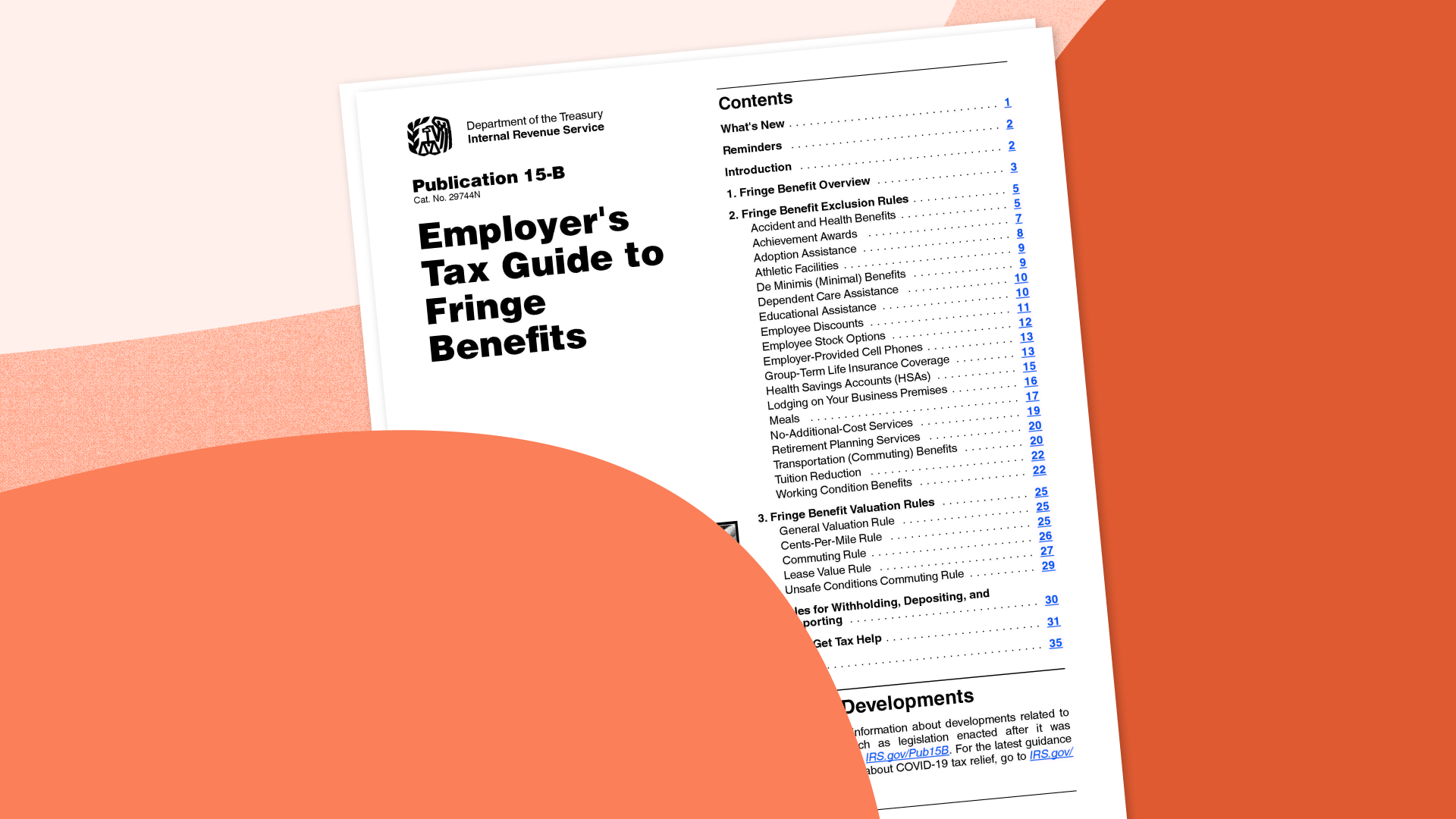What Are Pre-Tax Deductions?
Common Types of Pre-Tax Deductions
How Pre-Tax Deductions Affect Employee Paychecks and Taxes
Limitations and Considerations
Planning for Maximum Financial Benefit
How Pre-Tax Deductions Impact Employers
Make Informed Financial Decisions
Justworks Helps Navigate Pre-Tax Deductions and Employee Benefits
Understanding pre-tax deductions is an important aspect of financial literacy, especially when it comes to making sense of payroll and related concepts, like take-home pay and payroll taxes. Pre-tax deductions provide a way for an employee to pay for certain benefits or set aside money for retirement in a way that reduces the amount of income tax they owe to the government.
Want to learn more? We’ve prepared this helpful guide covering what you need to know, including what pre-tax deductions are, the various types of pre-tax deductions available, and how they can impact your finances.
What Are Pre-Tax Deductions?
Pre-tax deductions are amounts taken from an employee's gross pay before any taxes are withheld. Rather than owing income tax on their full gross income, an employee will be required to pay tax on the portion of their income that remains after pre-tax deductions have been subtracted.
Pre-tax deductions are allowed for various purposes, such as contributing to retirement plans, paying for health insurance premiums, and paying for certain other types of employee benefits.
The Benefits of Pre-Tax Deductions
The primary advantage of pre-tax deductions is that they lower an individual's taxable income, which can result in lower tax withholdings throughout the year and an overall reduced tax bill at the end of the year. By reducing taxable income, pre-tax deductions can lead to considerable tax savings.
For example, if an employee earns $50,000 a year and has $5,000 in pre-tax deductions, their taxable income falls to $45,000. Depending on various factors – such as whether they or a spouse have other income and how much, a reduction in taxable income could potentially drop them into a lower tax bracket, leading to further tax savings.
Common Types of Pre-Tax Deductions
There are several types of pre-tax deductions that individuals may encounter in their paychecks. Here's a look at some of the most common ones:
Qualified Retirement Plan Contributions [401(k) and 403(b)]
Contributing to a qualified retirement plan, such as a 401(k) or 403(b) account, is one of the most common pre-tax deductions. These plans allow employees to save a portion of their income for retirement while reducing their current taxable income and deferring income taxes on the money until withdrawal during retirement. In some cases, an employer may match a portion of what their employees contribute, further increasing the value of contributing to a qualified retirement plan.
Health Insurance Premiums
Group health insurance is another area where pre-tax deductions can help reduce an employee’s taxable income and may thus lower their income tax liability. When an employee participates in group health insurance, their portion of the premium (for themselves and their dependents) is usually paid with pre-tax dollars. This is also usually the case with dental and vision insurance premiums.
Flexible Spending Accounts (FSAs)
A Flexible Spending Account (FSA) is a special account in which employees can set aside money for specific health care or dependent care expenses. The money contributed to an FSA is not subject to payroll taxes, resulting in tax savings on money the employee would spend anyway. FSA funds can be used to pay for covered out-of-pocket health care expenses, such as copays for medical visits, prescriptions, child care, and other qualified expenses, via a debit card or reimbursement.
Health Savings Accounts (HSAs)
A Health Savings Account (HAS) is a tax-advantaged account that employees who have a High-Deductible Health Plan (HDHP) can use to save for medical expenses. As with an FSA, contributions to an HSA are made with pre-tax dollars, resulting in a reduction in taxable income and income tax liability.
Note: An individual who has an HSA is not eligible for an FSA for medical expenses but can still participate in an FSA specific to dependent care expenses. For more details, explore our FSA & HSA guide for employees.
Commuter Benefits
Some employers offer commuter benefits as a pre-tax deduction. These deductions help employees save income tax on certain costs associated with commuting to work. The Internal Revenue Service (IRS) allows employers to contribute to an employee’s commuting expenses in a way that doesn’t count toward their taxable income as a fringe benefit. Alternatively, an employee can opt to participate in a pre-tax compensation reduction arrangement, through which they set aside pre-tax deductions to cover qualified transportation costs such as transit passes, carpool expenses, or parking.
Life Insurance Premiums
Some group life insurance coverage that an employee can access as part of their benefits package can be paid for with pre-tax dollars. For life insurance that is directly or indirectly carried by an employer to cover an employee, there is no income tax on the premiums as long as the policy has a face value of $50,000 or less. This is true whether the employer pays for the policy or if the employee pays for the premiums via payroll deduction. If, however, additional coverage is added, the portion of the premiums that goes to provide more than $50,000 of coverage cannot be paid for via a pre-tax deduction.
How Pre-Tax Deductions Affect Employee Paychecks and Taxes
Pre-tax deductions have a direct impact on take-home pay and tax obligations. By lowering taxable income, these deductions can decrease the amount of federal income tax, Social Security tax, and Medicare tax owed.
Understanding Your Pay Stub
When reviewing a pay stub, it's important to differentiate between pre-tax and post-tax deductions. Pre-tax deductions appear above the line showing your taxable income because they have been subtracted from the amount of income on which your earnings are subject to tax deductions. Your post-tax deductions will come after the line that specifies your taxable income.
Calculating Tax Savings
To estimate the tax savings from pre-tax deductions, you'll need to consider your income tax bracket. As the deductions reduce your taxable income, you pay less tax at your marginal tax rate. The higher your tax bracket, the more significant your savings can be as a result of utilizing pre-tax deductions as allowed.
Limitations and Considerations
While pre-tax deductions offer tax benefits, there are limitations and considerations to keep in mind:
Contribution Limits
Many pre-tax deduction options, such as retirement accounts and FSAs, have annual contribution limits set by the IRS. It's important to stay within these limits to avoid penalties.
Eligibility Requirements
Certain deductions may have eligibility requirements. For instance, to contribute to an HSA, you must be enrolled in a high-deductible health plan. Those who have other types of health plans are not eligible to participate in an HAS.
Impact on Social Security Benefits
Because pre-tax deductions reduce the amount of a person’s income that is subject to Social Security tax, these deductions may also lower the earnings used to calculate future Social Security benefits.
Planning for Maximum Financial Benefit
Planning is essential to make the most of pre-tax deductions. Here are some steps to consider:
Review Your Benefits Package
Take a close look at your employer's benefits package to understand the pre-tax deductions available to you. Make sure you know which benefits can be excluded from your taxable income and which cannot be excluded so you can make a fully informed decision about which options align with your financial goals and needs.
Adjust Your Contributions
If you're not already maximizing your pre-tax deductions, consider adjusting your contributions to take full advantage of the tax benefits. Doing so can help you maximize your access to helpful fringe benefits while minimizing the size of your income tax liability.
Consult a Financial or Tax Advisor
Not sure how to make the most of the pre-tax deductions available to you? Consider reaching out to a financial or tax advisor for help. A knowledgeable financial or tax advisor can help you navigate the complexities of pre-tax deductions and develop a strategy that maximizes your tax savings and financial well-being.
How Pre-Tax Deductions Impact Employers
Pre-tax deductions don’t just benefit employees. They can also benefit employers in a number of ways. For example:
When employees choose to contribute to pre-tax benefits like retirement plans or health insurance, this reduces the amount of taxable income in the overall payroll. As a result, the employer’s portion of payroll tax contributions is also reduced.
Employers may also benefit from offering pre-tax deductions as part of their overall benefits package, as providing candidates and employees with valuable tax-saving opportunities can help them attract and retain talented employees.
Make Informed Financial Decisions
Pre-tax deductions are a valuable tool for reducing taxable income and maximizing take-home pay for employees while also helping companies reduce their overall payroll tax liability. By understanding how pre-tax deductions work for various fringe benefits, along with how these deductions impact finances for employees and businesses alike, it is possible to make informed financial decisions.
Justworks Helps Navigate Pre-Tax Deductions and Employee Benefits
If your company is looking to provide a comprehensive employee benefits package that makes it possible for employees to maximize pretax deductions while also keeping the administrative burden of benefits enrollment and payroll processing manageable, Justworks is here to help. We provide our customers with easy-to-use payroll and HR software and access to a quality employee benefits and perks at a fair price, along with compliance assistance, 24/7 customer service, and much more.
Whether your company is a small but mighty startup or growing small business, we’re here to help you – and your employees – leverage the benefits of pre-tax deductions and more. Dive in and get started today.
Learn more with Justworks’ Resources
Scale your business and build your team — no matter which way it grows. Access the tools, perks, and resources to help you stay compliant and grow in all 50 states.







